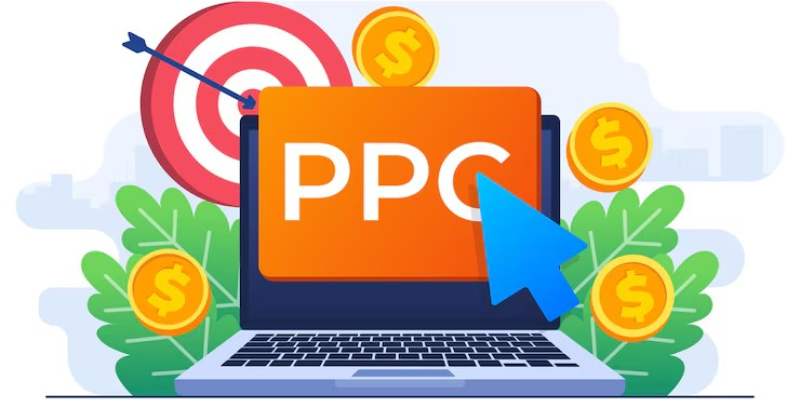

Modern digital marketing requires businesses to find equilibrium between their paid advertising strategies and their website performance metrics. PPC campaigns function to deliver traffic that culminates into leads or sales when optimized by CRO strategies. The alignment of PPC campaigns with CRO goals represents a fundamental requirement which delivers superior results.
This guide will show you how to implement effective strategies between your PPC advertising and Conversion Rate Optimization goals so you achieve better return on investment and more efficient digital marketing management. A well-designed CRO-focused PPC strategy can help you bridge the gap between traffic and conversions effectively. If you're looking for professional conversion rate optimization services, these strategies will set you on the right track.
PPC (Pay-Per-Click Campaigns) - A pay-per-click campaign functions as online advertising because marketers must pay every time visitors click their ads. The advertising platforms Google Ads, Bing Ads, and social media functions together to generate targeted traffic for these customized campaigns. Incorporating PPC optimization for conversions ensures that every click is valuable.
CRO (Conversion Rate Optimization) - CRO works to boost website visitor completion rates for specific actions which include form submissions and purchases alongside newsletter signup. The optimization process of CRO includes analyzing user behavior for website content adjustments and fundamental element testing. When PPC and CRO are aligned, they create a powerful synergy: PPC drives visitors to your site and CRO takes care of turning those visitors into desired actions. Utilizing conversion tracking in PPC helps measure this synergy effectively.
Initiating successful PPC and CRO integration begins through definitional clarity regarding each respective goal. Business targets require goals that establish measurable targets which define specific areas for achievement. A CRO-focused PPC strategy should aim to turn clicks into conversions seamlessly.
PPC Goal: A program should generate 1,000 page views of this landing page using ads at $2 per interaction.
CRO Goal: Audience completion will reach 20% throughout this particular landing page.
Setting these clear objectives establishes both a clear cause and effect relationship between PPC traffic volume and user interactions with your site.
The success of PPC and CRO functions requires landing pages as their central component. Users who access your paid advertisements through clicks will experience content which reacts to their original search interests when your landing page is optimized well for their intended target.
Match Ad Copy with Landing Page Content: Your landing page must contain messaging that precisely matches the text found in your display ads. A consistent user experience builds trust while lowering the number of users who leave your page.
Simplify Navigation: Keep your users focused on the primary action goal by removing side elements from your content and highlighting the main call-to-action (CTA).
Use Compelling CTAs: Use benefit-focused CTAs with actionables like "Get Your Free Quote" and "Start Your Trial Today."
Speed Up Page Load Times: Fast webpage loading times create two distinct effects on user experience since they determine how quickly visitors interact with your content and sites. PageSpeed Insights from Google provides tools for performance optimization.
A/B Testing: Regular evaluation of content components including text and visual elements and CTA structures helps determine which components perform best with your audience. This is a critical part of any CRO-focused PPC strategy.

For successful PPC-CRO alignment, marketers should focus on reaching the correct audience segment. Site conversions suffer when your advertising campaign targets inappropriate audiences, creating both financial wastage and minimal response.
Demographics: Your audience selection becomes easier through niche filters that examine the demographics of age, gender, income levels along with location-based criteria.
Interests and Behaviors: Unity interest-based targeting to find demographics that exhibit maximum purchase potential.
Remarketing Campaigns: The audience contains past site visitors and former brand customers.
Lookalike Audiences: Your existing customer information allows you to develop matching audience characteristics which you can use to build targeted recommendations.
By aligning your PPC targeting with your CRO goals and utilizing conversion tracking in PPC, you ensure that you’re bringing qualified traffic that is more likely to convert.
Your Advertising text acts as your first customer touchpoint through PPC ads. People are less likely to convert even after clicking ads when your ad copy creates unrealistic expectations.
Focus on User Intent: Design promotional messaging to focus on what problems and needs your target audience needs solved.
Highlight Benefits: Show users a clear explanation about the reasons they should click through your ad into new experiences or benefits.
Incorporate CTAs: Action-driven messaging works best with directives such as “Shop Now” and “Learn More” and “Sign Up Today.”
Test Variations: Use A/B testing to evaluate ad headline and description and Call-to-Action combinations because it helps determine which version performs best.
Your ad texts that match both your landing page content and conversion rate optimization goals help users maintain interest which leads to spending. Combining this with PPC optimization for conversions can deliver exceptional results.
Data analysis serves as a fundamental requirement to keep PPC campaigns properly focused on achieving CRO objectives. Monitoring relevant metrics helps to find actionable gaps that lead to development opportunities.
Click-Through Rate (CTR): PPC performance results from how well your ads match the interests of your audience.
Conversion Rate: Your conversion metric shows the ability of your landing page to transform page clicks into completed actions.
Bounce Rate: Your site experiences users exiting without any interaction which rates the bounce.
Cost Per Conversion (CPC): Using this metric helps determine the effectiveness of your PPC investment.
Quality Score: Quality Score represents Google's assessment of both your advertising content and landing page substance relevance.
By regularly analyzing these metrics and leveraging conversion tracking in PPC, you can refine your campaigns and make data-driven decisions to improve results.
Strategic PPC approaches produce major improvements when integrated with CRO objectives. Your real-time campaign adaptations activated by user behavior will boost both traffic quality and conversion rates.
Dynamic Keyword Insertion: A key feature inserts search keywords directly into advertisements according to user inquiry terms.
Responsive Search Ads: The Google system analyzes text variations to discover optimal headline-and-description pairings for search ads.
Geo-Targeting: The advertising system adjusts price points while adding content elements that target each individual user according to their present location.
Time-Based Adjustments: Maximize your ad delivery rate when conversion opportunities reach their peak moment.
Dynamic strategies create adaptable PPC campaigns which deliver better CRO results and match changing objectives.

PPC and CRO management pathways function independently although they work together through specialized groups of advertising professionals alongside web developers and designers. Seamless alignment requires key collaboration between all relevant teams.
Set Common Goals: Teams must reach collective agreement about main performance goals including conversions and cost-per-acquisition targets.
Share Data: Markets should conduct frequent exchanges of performance and insight data between their PPC specialists and their CRO specialists.
Hold Joint Reviews: The organization should commit time to conduct performance reviews and discover ways to enhance their campaigns through scheduled meetings.
Through collaboration, your organization will develop one cohesive system which connects advertising performance with customer acquisition metrics. By fostering collaboration and focusing on PPC optimization for conversions, you can create a unified approach that bridges the gap between traffic generation and conversion.
Experts recommend a collection of tools which help PPC teams reach their CRO targets using analytic features and automated functionalities alongside optimization systems.
Google Analytics: The system records user actions as well as tracking conversion achievements.
Google Ads: The system provides crucial data about advertising performance together with targeted audience analytics.
Hotjar: Database Heatmaps alongside session recordings provide users with behavioral analysis tools.
Unbounce: Unbounce simplifies page design alongside landing page testing functions.
SEMrush: Helps with keyword research and competitive analysis.
A strategic connection between PPC advertising and CRO objectives leads to noteworthy digital marketing performance improvements. A combination of clearly established objectives, optimized landing pages, targeted audience focus and relevant metric analysis produces systems which convert website visits into conversions. Well-venued cooperation between different teams when utilizing adaptive strategies ensures your campaigns maintain both agility and effectiveness.
Your business regardless of its size can benefit from implementing these procedures to improve results while maximizing return on investment. Your digital marketing achievement potential awaits you right now by bringing your PPC and CRO strategies into symphony. Start aligning your PPC and CRO strategies today to unlock your full potential in the digital marketing space, powered by a strong CRO-focused PPC strategy and precise PPC optimization for conversions. If you’re seeking expert guidance, consider partnering with a PPC company in Chennai to refine your strategies and achieve even greater success.